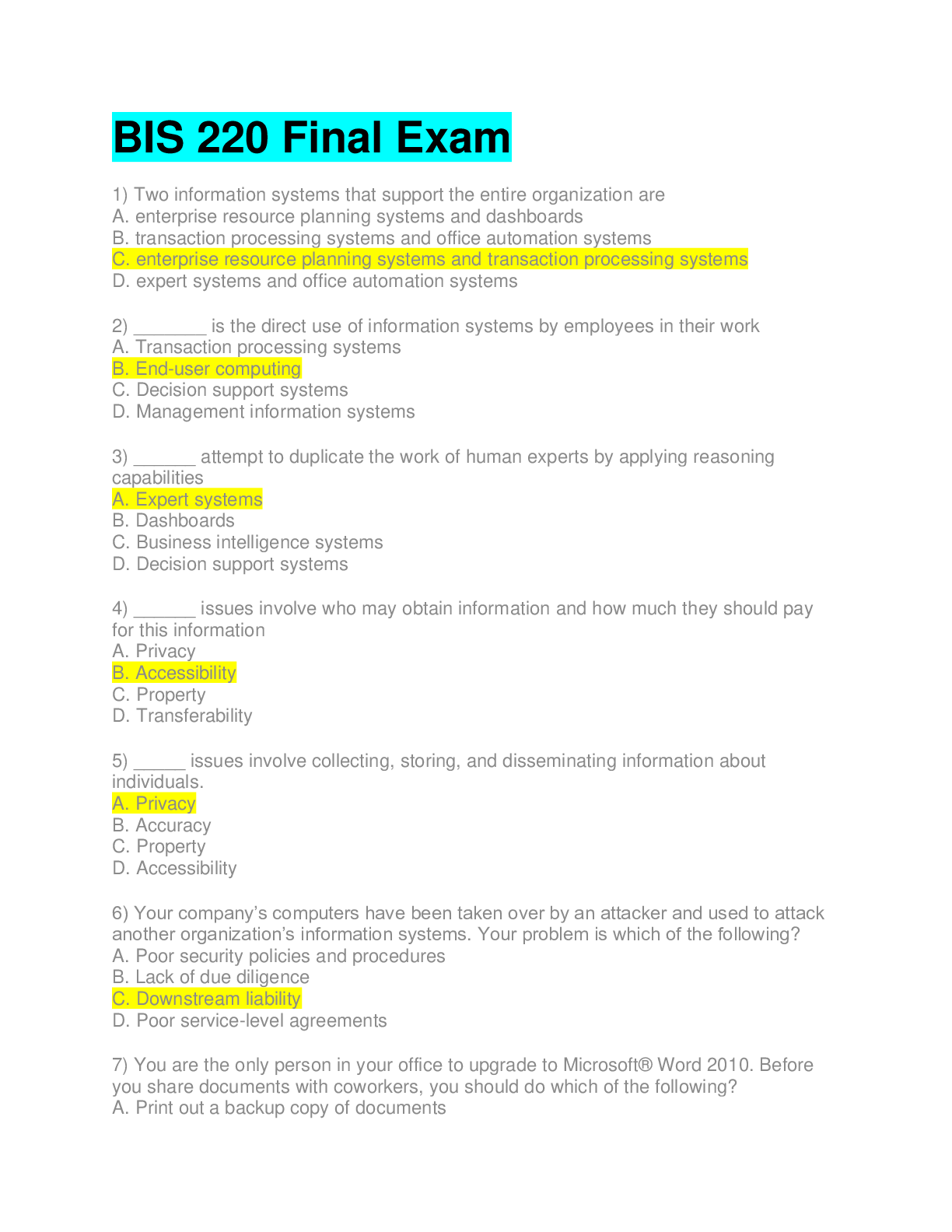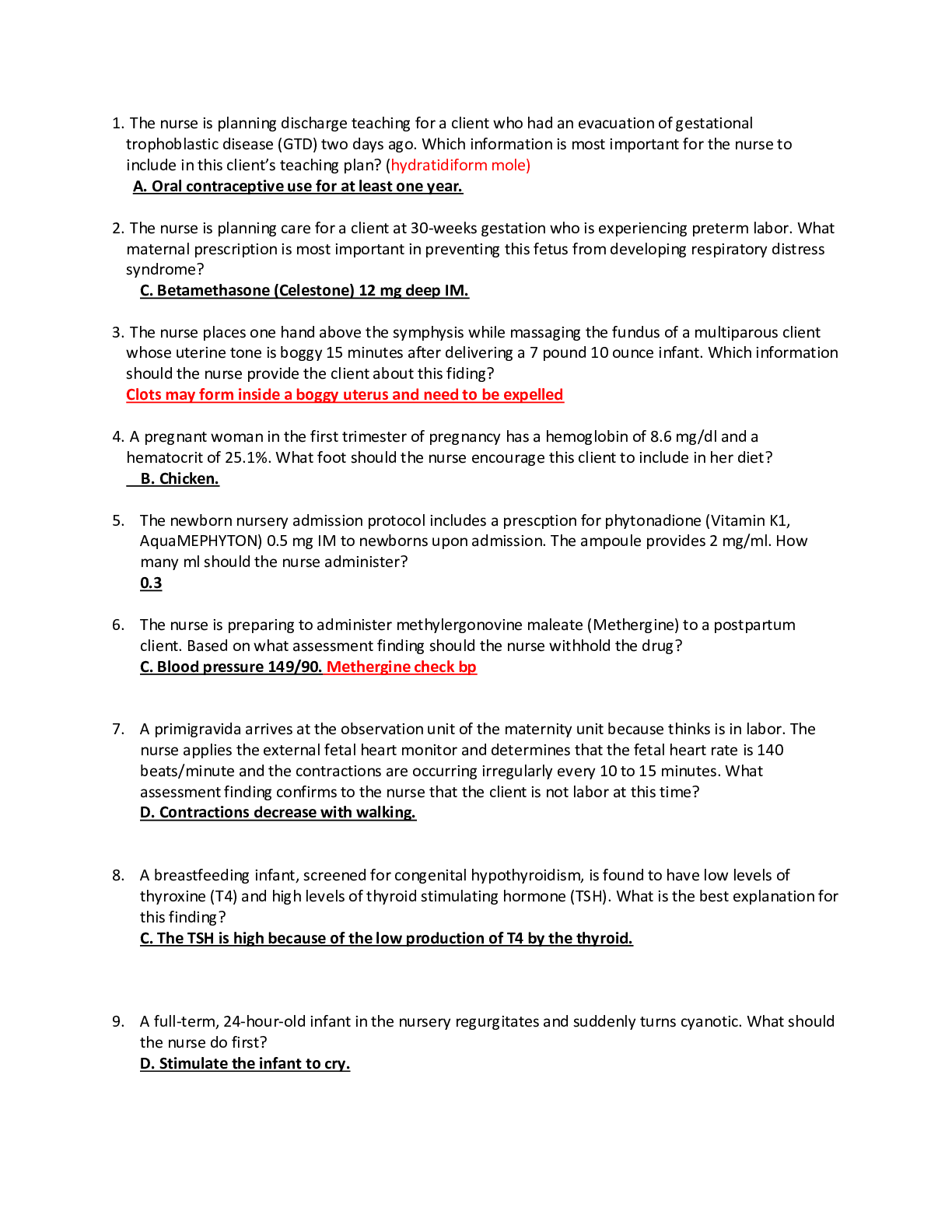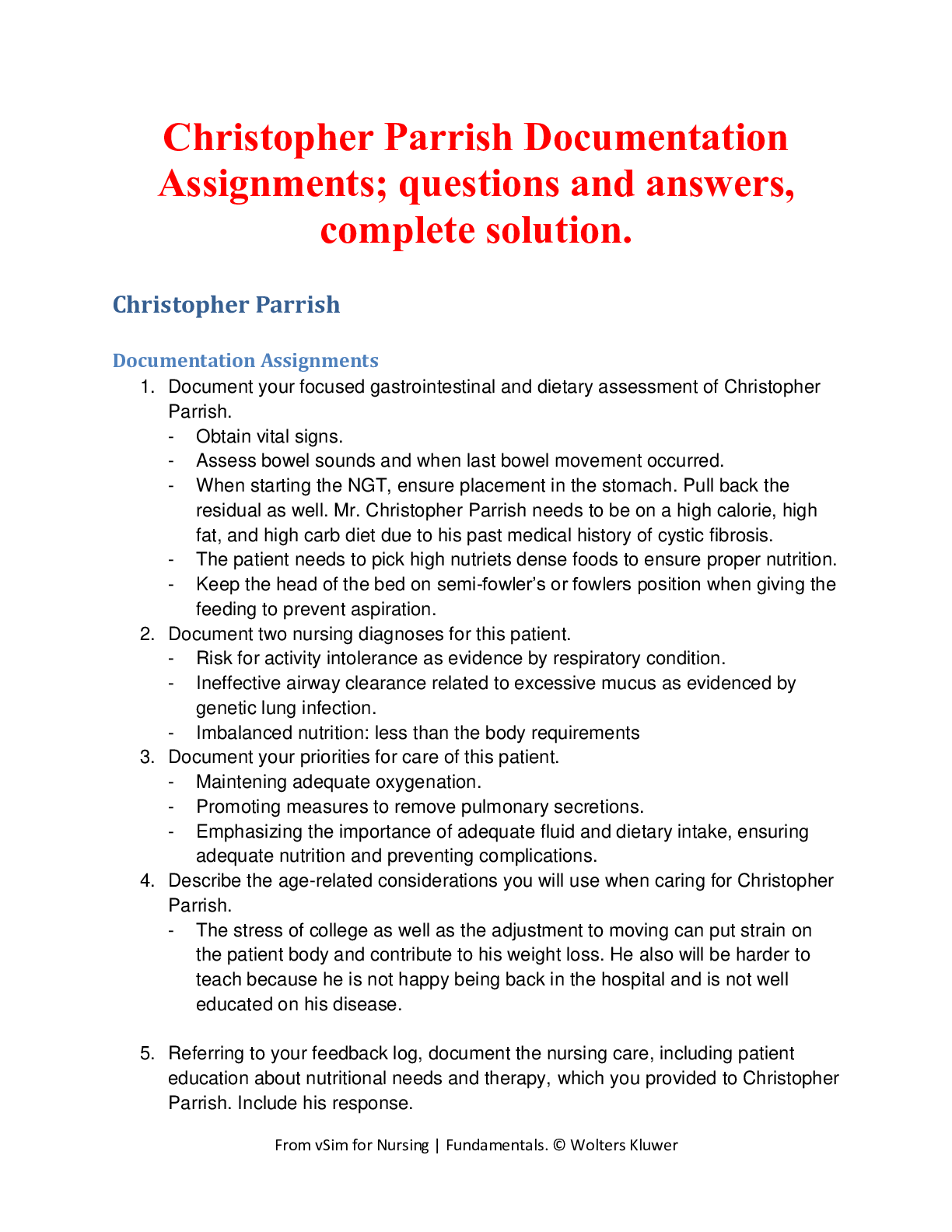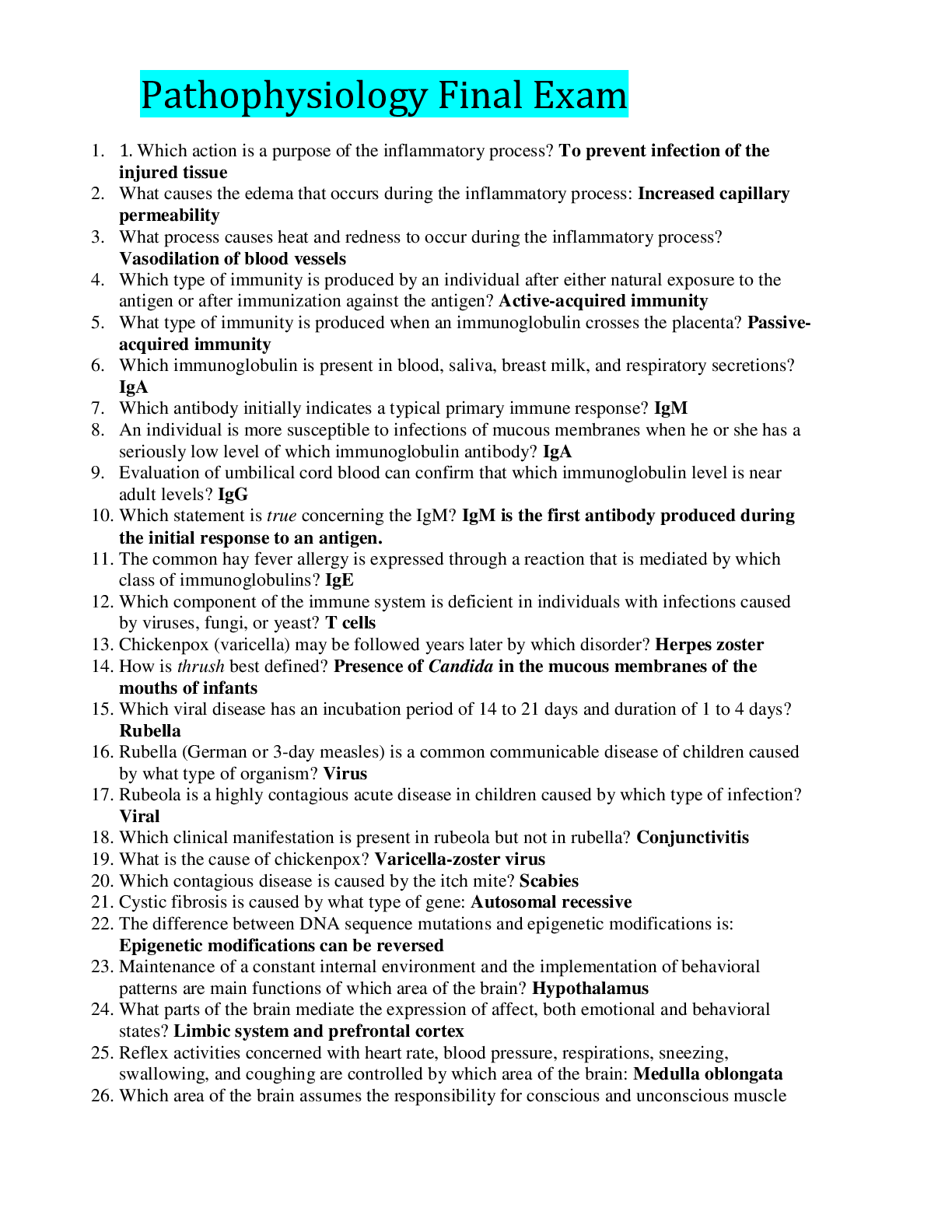*NURSING > QUESTIONS & ANSWERS > Chapter 15 Communication and Documentation. Questions and answers, 2022. Rated A (All)
Chapter 15 Communication and Documentation. Questions and answers, 2022. Rated A
Document Content and Description Below
Chapter 15 Communication and Documentation. Questions and answers, 2022. Rated A Which of the following BEST describes a base station? A two-way radio at a fixed site tA device used to receiv... e and then amplify transmissions that must be carried over long distances A two-way radio mounted in a vehicle A two-way radio that can be carried on a belt clip - ✔✔A two-way radio at a fixed site Which of the following BEST describes a mobile radio? A two-way radio that can be carried on a belt clip A two-way radio that is mounted in a vehicle A two-way radio at a fixed site A device that receives and amplifies signals that must be sent over a long distance - ✔✔A two-way radio that is mounted in a vehicle Which of the following BEST describes a portable radio? A device that receives and amplifies signals that must be sent over long distances A two-way radio that is mounted in a vehicle A two-way radio at a fixed site A two-way radio that can be carried on a belt clip - ✔✔A two-way radio that can be carried on a belt clip Which of the following BEST describes a repeater? A two-way radio that is mounted in a vehicle A two-way radio that can be carried on a belt clip A device that receives and amplifies a signal that must be carried over long distances A two-way radio at a fixed site - ✔✔A device that receives and amplifies a signal that must be carried over long distances You are treating a 32-year-old man who is deaf. You need to find out why he called for an ambulance. What is the BEST way to communicate with this patient? Use hand gestures to act out what you are trying to say. Make sure the patient can see your lips when you speak. Call for an interpreter to meet you at the hospital. Speak very loudly in case he has a little hearing. - ✔✔Make sure the patient can see your lips when you speak. Which of the following agencies assigns and licenses radio frequencies? The United States Department of Transportation The Transportation Security Administration The Federal Trade Commission The Federal Communications Commission - ✔✔The Federal Communications Commission Which of the following may vary from one ambulance service to another? Terms used to acknowledge a radio transmission Situations when a radio report is required Terminology for expressing the priority level of the transport or response mode All of the above - ✔✔All of the above Which of the following is NOT considered a principle of proper radio usage in EMS? Speak with your lips 2 to 3 inches from the microphone. Speak as quickly as possible. Use plain English. Make sure the radio is on before speaking. - ✔✔Speak as quickly as possible. During your radio report to the hospital, which of the following pieces of information should NOT be relayed? Patient's age Patient's name Baseline vital signs Patient's status - ✔✔Patient's name How many parts does a standard medical radio report have as described in your textbook? 12 8 5 10 - ✔✔12 Which of the following is NOT part of a medical radio report? Estimated time of arrival Address at which the patient was located Unit identification Patient's response to medical care provided - ✔✔Address at which the patient was located Which of the following information does NOT need to be provided to the dispatcher? Which hospital you are transporting to Estimated time of arrival at the hospital When you depart from the hospital When you arrive at the hospital - ✔✔Estimated time of arrival at the hospital When giving a radio report to the hospital, which of the following should be stated first? The patient is complaining of chest pain. The patient has taken nitroglycerin. The patient is a 55-year-old male. The patient is having a heart attack. - ✔✔The patient is a 55-year-old male. Which of the following is NOT appropriate for inclusion in the radio report to the receiving hospital? Physical exam findings The patient's mental status Name of the patient's health insurance provider Pertinent past illnesses - ✔✔Name of the patient's health insurance provider You have received an order from medical direction that you feel would be detrimental to your patient. Which of the following should you do? Politely question the physician. Carry out the order but document that you disagreed with it. Contact your supervisor for advice. Call a different hospital for orders. - ✔✔Politely question the physician. Medical direction has requested that you administer 70 grams of activated charcoal to an overdose patient. Which of the following should you do next? Document the order in writing before carrying it out. Repeat the order back to the physician to make sure you understood correctly. Administer the medication without delay. Prepare the medication and then call the hospital back to re-confirm the order. - ✔✔Repeat the order back to the physician to make sure you understood correctly. Which of the following is NOT a required time to communicate your location to the dispatch center? You are staged and awaiting arrival of law enforcement. You are stopping to get lunch. You have arrived at the hospital. You have arrived on the scene. - ✔✔You are stopping to get lunch. You are treating a patient with a possible fractured ankle. The patient appears to be in a lot of pain and is uneasy. As you are getting ready to splint the patient's leg, he asks you if it is going to hurt. Which of the following is the BEST response? "If you're stressed out like this, it's going to hurt a lot more." "Relax, this is not a painful procedure." "I will do my best, but it may hurt while we put the splint on." "It doesn't matter, we have to do it anyway." - ✔✔"I will do my best, but it may hurt while we put the splint on." You are responding to a nursing home for an 85-year-old patient complaining of difficulty breathing. How would you initiate contact with this patient? Stand near the head of the bed and shout to make sure the patient can hear you. Place yourself at eye-level, identify yourself, and ask the patient what she would like to be called. Sit on the foot of the bed and ask the patient what's up. Pick up the patient's wrist and begin taking her pulse. - ✔✔Place yourself at eye-level, identify yourself, and ask the patient what she would like to be called. Which of the following is NOT an appropriate way of dealing with a patient who does not speak the same language as you do? Avoid communicating with the patient so there is no misunderstanding of your intentions. Use an interpreter. Contact dispatch for assistance in finding a translator. Use a manual that provides translation. - ✔✔Avoid communicating with the patient so there is no misunderstanding of your intentions. You are on the scene of an adult male in cardiac arrest. The patient's wife is upset and is asking you if her husband is going to be okay. How should you answer the patient's wife? "Your husband is in cardiac arrest and people usually do not survive in these circumstances." t"Please wait in the other room. We'll let you know as soon as we know something." "Your husband's heart has stopped. We're doing everything we can." "Yes, he will be fine." - ✔✔"Your husband's heart has stopped. We're doing everything we can." Which of the following BEST describes the importance of effective communication of patient information in the verbal report? Patient treatment can be based on this information. Additional information that was not given in the radio report can be provided. Changes in the patient's condition can be communicated. All of the above - ✔✔All of the above Which of the following BEST describes the position you should take when dealing with a cooperative patient who is sitting in a chair? Sit or kneel at the same level as the patient. Stand behind the patient's chair. Stand next to the chair. Sit on the floor at the patient's feet. - ✔✔Sit or kneel at the same level as the patient. You are attempting to place a nonrebreather mask on a patient who is experiencing difficulty breathing. The patient is anxious and does not want the mask on his face. Which of the following is the BEST course of action? Tell the patient the mask is for his benefit and you will restrain him if necessary to place it on him. Explain the importance of oxygen and ask the patient to at least try to leave the mask on, but that if he can't tolerate it you can try another method. Tell the patient he will soon become unconscious without the mask and then you will be able to place it on him. Document that the patient was uncooperative and refused oxygen. - ✔✔Explain the importance of oxygen and ask the patient to at least try to leave the mask on, but that if he can't tolerate it you can try another method. Your elderly male patient tells you his name is Joe Smith. Which of the following is the BEST way to address him? Joe Smitty Mr. Smith Sir - ✔✔Mr. Smith You have an urgent transmission you need to make to the dispatch center. Which of the following is the appropriate way to communicate this? Interrupt less urgent radio traffic to get your message across. Speak loudly to convey the urgency of the message. Listen to the frequency first to avoid stepping on another transmission. Use the phrase, "Attention, attention, I have priority traffic." - ✔✔Listen to the frequency first to avoid stepping on another transmission. Which of the following is appropriate when communicating patient information to the hospital over the radio? Provide the patient's last name and social security number so the emergency department staff can request the patient's medical record before he arrives. Avoid information that does not assist the emergency department in preparing to receive the patient. Speak quickly to get all of the information in without monopolizing radio air time. Give a complete medical history to ensure the emergency department is prepared. - ✔✔Avoid information that does not assist the emergency department in preparing to receive the patient. Your patient is a 43-year-old woman with chest pain. You have called the communications center and asked for an ALS unit to be dispatched to your location. While en route, the ALS unit calls you for a report. Which information is most important to the ALS unit at this time? The length of time you have been on the scene The patient's medications The patient's past medical history The patient's level of consciousness and chief complaint - ✔✔The patient's level of consciousness and chief complaint For which of the following reasons is it NOT appropriate to give a patient's name over the radio? It is not pertinent to patient care. It is a violation of the patient's privacy and confidentiality. The radio transmission may be heard by others not involved in the patient's care. All of the above - ✔✔All of the above After you give your radio report to the hospital, your patient becomes unresponsive. Which of the following should you do next? Reassess the patient. Notify dispatch of a change to emergent transport mode. Immediately notify the hospital of a change in patient priority. Call for ALS. - ✔✔Reassess the patient. You are transporting a city councilman to the hospital after he injured his shoulder playing basketball at his gym. His left shoulder is swollen, deformed, and bruised. There is pain and tingling when the patient attempts to use his hand. He has a pulse of 92 per minute, a respiratory rate of 20 per minute, and a blood pressure of 132/88 mmHg. Which of the following should NOT be included in the radio report? The appearance of the shoulder Notification that extra security is needed for a VIP How the injury occurred Vital signs - ✔✔Notification that extra security is needed for a VIP You have received the following order from medical control: "Administer one tablet of nitroglycerin under the patient's tongue." Which of the following is the BEST response? "Roger, order received." "Order received. One nitroglycerin tablet under the patient's tongue." "Clear. Will advise of any changes in patient's condition."Copy. Administering medication now." - ✔✔"Order received. One nitroglycerin tablet under the patient's tongue." Which of the following statements regarding eye contact with a patient is NOT true? It shows you are confident. It shows you are attentive. It shows you are interested in the patient. Eye contact is always appropriate. - ✔✔Eye contact [Show More]
Last updated: 1 year ago
Preview 1 out of 21 pages
Instant download

Buy this document to get the full access instantly
Instant Download Access after purchase
Add to cartInstant download
Reviews( 0 )
Document information
Connected school, study & course
About the document
Uploaded On
Aug 22, 2022
Number of pages
21
Written in
Additional information
This document has been written for:
Uploaded
Aug 22, 2022
Downloads
0
Views
94





















.png)



